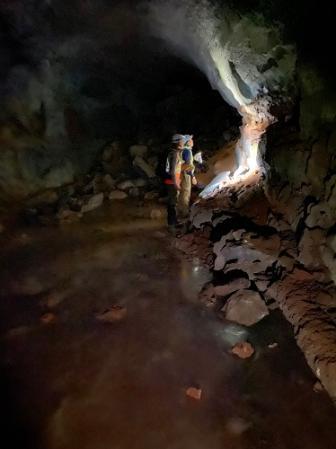 In June 2022, Dr Sam Kelley (UCD Earth Sciences) travelled to the US Pacific Northwest to participate in a NASA Field Expedition to Lava Beds National Monument in Northern California, USA, funded in part by the UCD Earth Institute. The project brings together a collection of geoscientists interested in examining terrestrial analogues for potential exploration sites on the Moon, Mars, and near-Earth asteroids. The field party comprised faculty, post-docs, and postgraduates from a range of collaborating universities, including the University of Maryland, University of South Florida, University of Arizona, Oregon State, University of New Hampshire, and John’s Hopkins, as well as staff from NASA centres Goddard and Ames. In total, the group seeks to test equipment and methodologies to facilitate the exploration of the Moon and other planets.
In June 2022, Dr Sam Kelley (UCD Earth Sciences) travelled to the US Pacific Northwest to participate in a NASA Field Expedition to Lava Beds National Monument in Northern California, USA, funded in part by the UCD Earth Institute. The project brings together a collection of geoscientists interested in examining terrestrial analogues for potential exploration sites on the Moon, Mars, and near-Earth asteroids. The field party comprised faculty, post-docs, and postgraduates from a range of collaborating universities, including the University of Maryland, University of South Florida, University of Arizona, Oregon State, University of New Hampshire, and John’s Hopkins, as well as staff from NASA centres Goddard and Ames. In total, the group seeks to test equipment and methodologies to facilitate the exploration of the Moon and other planets.
Dr Kelley’s research focuses on how landscapes change. By using cosmogenic nuclides, specific isotopes produced on Earth’s surface via incoming radiation from space, he is able to examine the timing and rate of Earth's surface processes. On this expedition, Dr Kelley was the field lead for the lava tube collapse team, whose goal was to determine how quickly long sinuous caves within lava flows, known as lava tubes, collapse after they are formed. To do this, Dr Kelley and his team collected rock samples from collapsed lava tubes, as well as from the flow surface and deep within the lava tube, to determine if collapse events occur early in a lava flow’s lifetime, resulting from fractures that form as a lava flow cools, or gradually through time due to changes in climate or seismic events.
This work's overarching goal is to understand the stability of lava tubes on Earth to de-risk future extra-terrestrial exploration. Lava tubes are naturally occurring features throughout our solar system; as such, they offer natural shelter from space hazards (such as radiation). By understanding the evolution of these features on Earth, we may better our understanding of how these features might be of use to crewed missions to the Moon and other planets.
Dr Kelley said, "Participation in this NASA expedition was both personally and professionally rewarding, and has opened a lot of opportunities for me. I’m quite grateful for the Earth Institute funding, which was quite timely in making my participation possible."